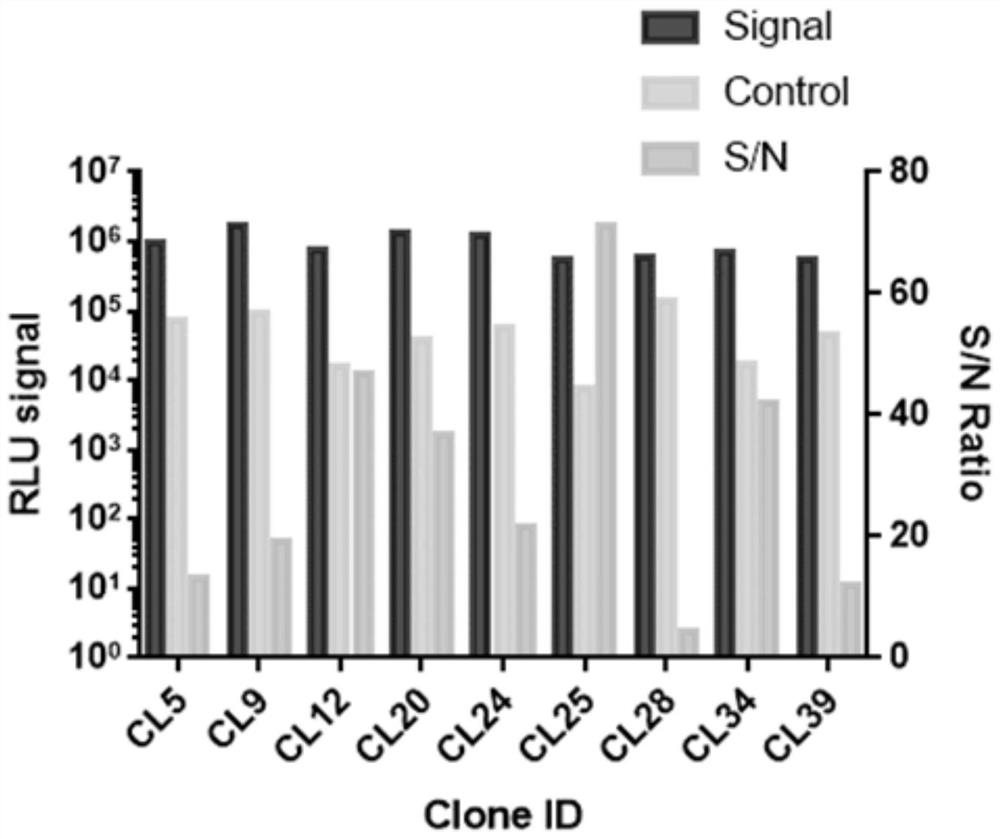Construction and application of Claudin18.2 reporter gene CHO-K1 stably transfected cell strain
A CHO-K1 and reporter gene technology, applied in the field of biomedicine, can solve problems such as interference, small signal-to-noise ratio window of the method, and poor sensitivity
- Summary
- Abstract
- Description
- Claims
- Application Information
AI Technical Summary
Problems solved by technology
Method used
Image
Examples
Embodiment 1
[0024] Example 1 Construction process of expressing Claudin 18.2 stably transfected cell line
[0025] Claudin 18.2 lentivirus (customized by Jinweizhi) was used to infect 1E4 cells / well of CHO-K1 cells (ATCC, Cat. No. CCL-61) in a 24-well plate at an MOI of 20, with a total volume of 1000 μL; The lentivirus was removed; on the third day, the digested cells were transferred to a 6-well plate and cultured under pressure in F12 medium with 500 μL / mL Hygromycin added. After maintaining 500 μg / ml Hygromycin in the F12 medium for growth, passage and pressurization for two generations, cells were plated in a 96-well plate on the 10th day; on the 30th day, the monoclonal observed in the 96-well plate was transferred to The orifice plate was transferred to a 6-well plate after evaluation and screening, and T25, T75, and T175 were cultured to obtain a single clone, clone number CA03.
Embodiment 2
[0026] Example 2 Evaluation of Transfection Efficiency of Monoclonal Cell Line Expressing Claudin 18.2
[0027] The optimal clone CA03 was selected and cultured in F12 medium supplemented with 500 μL / mL Hygromycin, and untransfected CHO-K1 cells were cultured at the same time. After trypsin digestion and counting, take 1E6 cells to a 1.5mL centrifuge tube, centrifuge at 1000rpm for 5min, discard the supernatant, leave about 100ul supernatant to resuspend the cells, add 5μL Anti-18.2-362Antibody, the final concentration is 5μg / ml, and mix well Minimize the generation of air bubbles, incubate at 4°C for 30 minutes, remove and add an appropriate amount of PBS, centrifuge at 1000 rpm for 5 minutes, discard the supernatant, repeat this operation twice, and add 5 μL Goat pAb to Hu IgG (PE) to the remaining 100 μL sample, with a final concentration of 5 μg / mL, incubate at 4°C for 30 min, take out and add appropriate amount of PBS, centrifuge at 1000 rpm for 5 min, discard the supern...
Embodiment 3
[0029] Example 3 Construction process of CMV-Luciferase reporter gene stably transfected cell line
[0030] CMV-Luc2 lentivirus (customized by Heyuanbio) MOI is 20, infects 1E5 cells / well of CHO-K1Claudin18.2 (CA03) cells in a 24-well plate with a total volume of 1000 μL; Virus; on the third day, the digested cells were transferred to a 6-well plate and cultured under pressure in F12 medium with 5 μL / mL Puromycin and 500 μg / mL Hygromycin. After maintaining pressurized 5 μL / mL Puromycin and 500 μg / mL Hygromycin in F12 medium for two passages, cells were plated in a 96-well plate at 1 cell / well on the 10th day; The single clone was transferred to a 24-well plate. After evaluation and screening, it was transferred to a 6-well plate. T25, T75, and T175 were cultured to obtain a single clone, the clone number being CL25.
PUM
 Login to View More
Login to View More Abstract
Description
Claims
Application Information
 Login to View More
Login to View More - R&D
- Intellectual Property
- Life Sciences
- Materials
- Tech Scout
- Unparalleled Data Quality
- Higher Quality Content
- 60% Fewer Hallucinations
Browse by: Latest US Patents, China's latest patents, Technical Efficacy Thesaurus, Application Domain, Technology Topic, Popular Technical Reports.
© 2025 PatSnap. All rights reserved.Legal|Privacy policy|Modern Slavery Act Transparency Statement|Sitemap|About US| Contact US: help@patsnap.com



